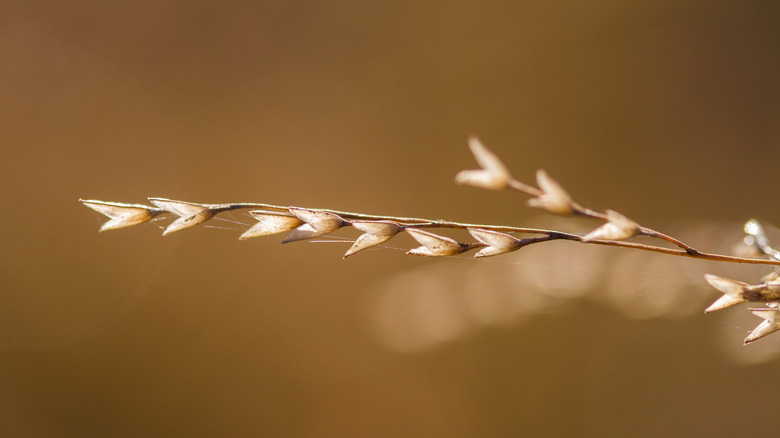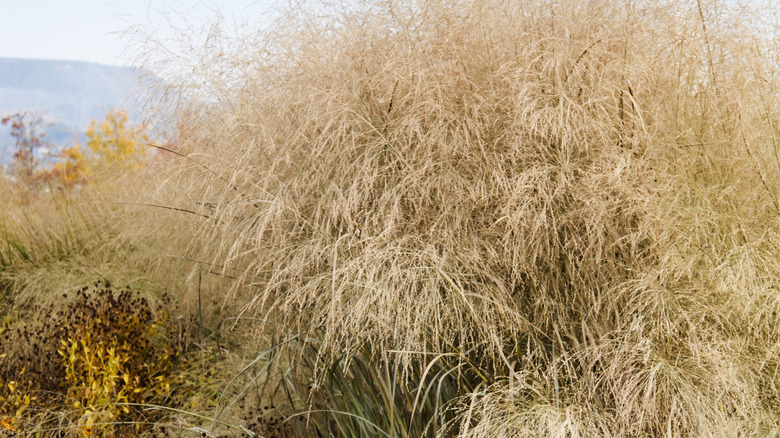Gardens anywhere outside of southern Florida tend to look sparse in winter. Trees have few or no leaves and beds are snow-covered. The lawn is lackluster, hit hard by frosts, and cold-sensitive plants are bundled in frost cloth or mulch. Winter’s challenging for feathered and furred garden visitors, too. It’s harder to find food, and there’s far less natural cover to hide from predators. Switchgrass is a popular option for U.S. growers looking to maintain interest in a winter garden while providing for wildlife — so long as you take care of it. This consists of leaving seedheads and leaves on the plant until mid-winter and cutting the stand back close to the ground in late winter. In frigid climates, your plants may need extra protection.
Panicum virgatum or switchgrass — also called panic grass, tall prairiegrass, wild redtop, or thatchgrass — is a perennial warm-season grass. It thrives through the spring, summer, and fall and goes dormant in winter in U.S. Hardiness Zones 3 to 9. The plant reaches 3 to 7 feet tall and gets as wide as 4 feet. In North America, its native habitat extends from Mexico into Canada, east of the Rocky Mountains. It spreads by rhizomes but is not problematic, making it a commonly suggested alternative for invasive maiden silvergrass. Come winter, the mid-summer blooms transform into dramatic red-purple seedheads, which are a cold-season wildlife food.
Winter-hardy

Switchgrass is often the last plant standing in the fall garden, even as the big freeze sets in. Snow falls off the plant’s narrow leaves and hardy seedheads. The sturdy crown naturally insulates the underground rhizomes. If the plant gets bent in heavy snowfall, it’ll typically pop upright again when the snow melts come spring. Switchgrass seeds benefit from natural stratification, where periods of frost and thaw help to crack open the hard shells, making sprouting easier. The rhizomes love the cold, too. In fact, switchgrass winter dormancy — called over-wintering — is vital for vigorous spring growth.
Because switchgrass holds up so well in the winter, some gardeners leave the plant be; it makes excellent ground and wild animal cover, and its abundant, stabilizing rhizomes put it among the ideal plants for a sloped yard. If you choose this route, check your stand in February and divide or remove diseased plants if needed. More proactive gardeners may prefer to cut back their switchgrass in mid-winter. The stems need to be 2 to 4 inches tall to expose any new shoots to fresh air and sunlight. The best tools for this job include hand saws, hedge trimmers, hand or hedge shears, hand pruners, or even your lawn mower. Keep the string trimmer in the shed unless you’re willing to risk a tangle. Though burning is a natural process for many native American grasses, attempting this at home is not advisable, given the associated safety and fire risks.
Garden tasks

Late fall and early winter are the times to start preparing your switchgrass stands for over-wintering. As winter approaches, your plant will begin to go to seed. Leave the seedheads on the plant through mid-winter to feed birds and small mammals. An exception is if you live in an area that regularly sees freezing temperatures (lower than -13 degrees). Instead, cover the crowns with mulch or soil to protect the rhizomes. Without this, your plant may not die, but it will have lackluster to non-existent growth come spring. Winter, or more accurately, mid-winter, is also the time to sow switchgrass seeds. Aim for 2 to 4 weeks before spring to give your seedlings time to put down roots for the growing season.
Stands take a while to establish. If yours is younger than three years and looks raggedy come spring (late April), you’re likely not doing anything wrong. The leaves naturally shift from green (spring and summer) to red-orange (fall) to brown (winter). Don’t panic if you see this; your plant isn’t dead! Upland switchgrass varieties are the most winter-hardy since they start preparing for winter at higher temperatures than their lowland counterparts. Some popular upload cultivars are Cave-in-Rock, Caddo, Shawnee, and Blackwell, among many others. In saying this, when buying switchgrass seedlings or seeds, look for plants that naturally occur in or directly adjacent to your USDA Hardiness Zone. Cultivars within the two ecotypes — upland and lowland — have adapted to the nuances of their native environment.



